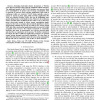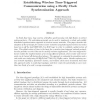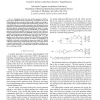718 search results - page 51 / 144 » Energy saving and network performance: a trade-off approach |
TMC
2010
13 years 2 months ago
2010
Emerging dual-mode phones incorporate a Wireless LAN (WLAN) interface along with the traditional cellular interface. The additional benefits of the WLAN interface are, however, lik...
WISES
2008
13 years 9 months ago
2008
In South-East Asia, huge swarms of fireflies synchronously emit light flashes to attract mating partners. The underlying principle can be used to implement a robust and scalable d...
ICC
2008
IEEE
14 years 2 months ago
2008
IEEE
— In large Wireless Sensor Networks (WSNs), each hop might incur varying delays due to medium access contention, transmission and computation delays. Fast and efficient query re...
DATE
2005
IEEE
14 years 1 months ago
2005
IEEE
Supply voltage scaling and adaptive body-biasing are important techniques that help to reduce the energy dissipation of embedded systems. This is achieved by dynamically adjusting...
ISVLSI
2003
IEEE
14 years 1 months ago
2003
IEEE
Abstract— Dissipation in the clock tree and state elements of ASIC designs is often a significant fraction of total energy consumption. We propose a methodology for recovering m...



